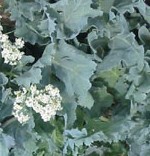 Sea kale is herbaceous perennial and a member of the mustard/cabbage family ( Brassicaceae) that also includes wallflowers, stock and horseradish. It is native to Europe and since the 18th century has been harvested from beaches in the UK for its shoots that were lightly boiled and served with lemon butter, béchamel, or hollandaise sauce. The height of its popularity was in the early nineteenth century but has declined since then and is now grown for its attractive leaves and flowers. The thick blue green leaves are cabbage-like, up to two feet long, and have wavy margins. They form a large spreading mound that is covered with dense flat racemes of small, white, four-petaled, fragrant, cruciform flowers ½” wide during the summer. The seed pods that follow are ¼ inch wide, spherical, and contain one seed. Plants tolerate some drought and salty soil above the high tide line. The genus name, Crambe, comes from the Greek word, κράμβη, a kind of cabbage. The specific epithet, maritima, is the Latin word meaning of the sea.
Sea kale is herbaceous perennial and a member of the mustard/cabbage family ( Brassicaceae) that also includes wallflowers, stock and horseradish. It is native to Europe and since the 18th century has been harvested from beaches in the UK for its shoots that were lightly boiled and served with lemon butter, béchamel, or hollandaise sauce. The height of its popularity was in the early nineteenth century but has declined since then and is now grown for its attractive leaves and flowers. The thick blue green leaves are cabbage-like, up to two feet long, and have wavy margins. They form a large spreading mound that is covered with dense flat racemes of small, white, four-petaled, fragrant, cruciform flowers ½” wide during the summer. The seed pods that follow are ¼ inch wide, spherical, and contain one seed. Plants tolerate some drought and salty soil above the high tide line. The genus name, Crambe, comes from the Greek word, κράμβη, a kind of cabbage. The specific epithet, maritima, is the Latin word meaning of the sea.
Type: Herbaceous perennial
Bloom: Small, white, four-petaled, fragrant, cruciform flowers ½” wide in flat racemes during the summer
Size: 30” H x 24” W
Light: Full sun; tolerates light shade
Soil: Fertile, light, moderately moist, well-drained
Hardiness: Zones 5-9
Care: Water regularly; fertilize in spring
Pests and Diseases: Club root, flea beetle
Propagation: Seed, root cuttings
Companion Plants: Sea rocket, sea purslane, sea milkwort and sea holly, lantana, bee balm, ivy geranium, bougainvillea.